Platinum Coins and Medals in Mexico
by Pablo Luna Herrerabased on his website (in Spanish) eldatonumismatico(/footnote}
Introduction
Platinum is one of the scarcest metals in existence and is highly prized in jewelry for its beauty, hardness, gloss, strength and durability. The main deposits of platinum in the world are in South Africa, Russia and Canada.
In 1557 this metal, when discovered between Mexico and Panama, was described as “incapable of being cast with fire or with any other device.” There are references to the use of pre-Colombian platinum. The Spaniards discovered it in Colombia and called it platina, meaning little silver, as at first they mistook it for silver. One of the first applications of platinum was to mint coins in the Spanish colonies: in fact it was used to counterfeit gold coins.
The use of platinum in the minting of coins is complicated because it is harder than gold and silver (to get an idea of the hardness of platinum: aluminum melts at 660 degrees Celsius, silver at 961 degrees Celsius, gold at 1064 degrees Celsius, whilst platinum melts at 1768 degrees Celsius). Coin dies are usually made of steel and with platinum blanks the die soon becomes damaged and unable to mint the coin correctly. This is the reason why many platinum mintages are low and not known with certainty.
The following research attempts to illustrate and explain most of the Mexican coins and medals minted in this metal. It is important to note that when contacted the Mexican Mint, Banco de México and members of the Sociedad Numismática de México said that they often do not have official reports of what was coined. Some of these pieces were made for firms, companies or foreign individuals, which is why they are rarely found in Mexico. It is assumed that when a person or organization requesting a medal presented a design or sketch to the Mint, when the design was ready, it was proofed in various metals for the client to choose from. Generally these proofs were in gold, silver and platinum, which is why we find the identical piece in different metals.
Many of these pieces were made during the administration of Napoleon Gomez Urrutia as head of the Mint (1979 to 1992). Moreover, in many cases no decrees or initiatives for the minting is known.
List of Platinum Coins and Medals in Mexico
1. The Platinum Centenario

This was probably the first coin minted in platinum in the history of Mexico, and likewise the rarest and most mysterious. In the 1950s a wealthy American businessman, Edward Metcalf, ask several mints in the world to mint their most emblematic coin in a different metal to the official coins. In the case of Mexico he asked for five Centenarios, identical to the original dated 1947 with the same weight, diameter and thickness, but in platinum. Thus these five pieces say “37.5 grams of pure gold” but are not gold, but platinum.
2. Panda Bear “Tohui’
In 1987 the Mexican government commemorated the fifth anniversary of “Tohui” which was the first panda to be born and survive in captivity outside China. Tohui was born to Pe Pe and Yin Yin in 1981 and died in 1993. This medal exists in three metals: gold, silver and platinum, with silver being the most known, but still scarce.
Silver
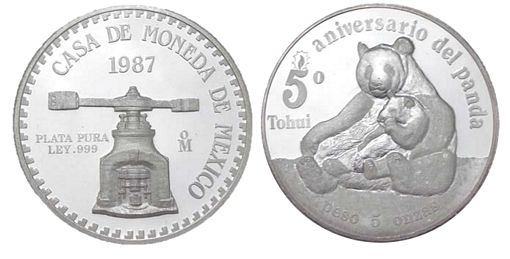 Tohui 5 onzas silver
Tohui 5 onzas silver
| Ley(fineness) | weight | diameter | number minted |
|
| 1 onza | 0.999 | 31.1 grams | 40.0 mm | unknown |
| 5 onzas | 0.999 | 155.0 grams | 64.9 mm | 1,000 |
| 12 onzas | 0.999 | 373.2 grams | 80.0 mm | 5,000 |
These pieces are known in satin and mirror finish, with foliated edging.
Gold
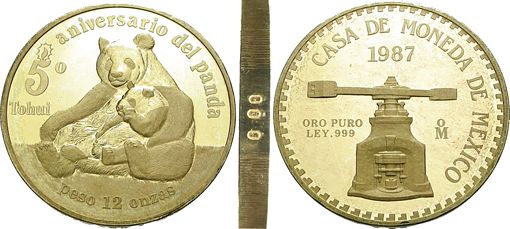
Tohui 12 onzas gold
According to records it is thought that this was minted in denominations of 1/10, ¼, ½, 1, 5 and 12 onzas, but so far only the four denominations below are known. The medals have foliated edgings. All are mirror finished.
| Ley(fineness) | weight | diameter | number minted |
|
| ½ onza | 0.999 | 33.0 mm | ||
| 1 onza | 0.999 | 40.0 mm | ||
| 2 onzas | 0.999 | 48.0 mm | ||
| 5 onzas | 0.999 | 65.0 mm | ||
| 12 onzas | 0.999 | 80.0 mm | 100 |
Platinum
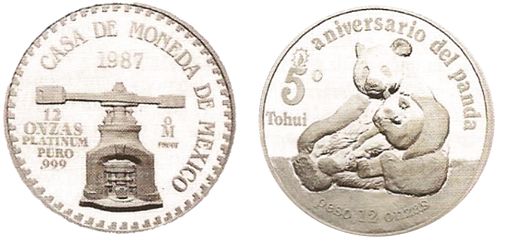
Tohui 12 onzas platinum
Only one denomination is known, in mirror finish or proof (with the legend “PROOF’ below the mintmark).
| Ley(fineness) | weight | diameter | number minted |
|
| 12 onzas | 0.999 | 80.0 mm |
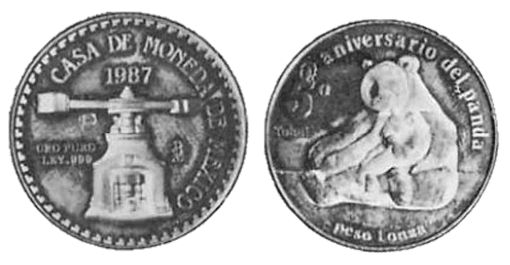
Tohui copper proof
There are also rare proofs of this medal done in copper. The image shows a 1 onza proof. The legend reads “Pure Gold” which makes us think that it was a proof for the gold medal. Below the minting press is the letter “P” which is not part of the die and could be an allusion to “Prueba” or “Pattern” in English.
3. The 1985 Project
In 1985, during the presidency of Miguel de la Madrid, his Secretario de Gobierno, Manuel Bartlett Díaz, proposed a change in the monetary law to authorize the minting of platinum. Briefly, it proposed the type minting of Libertads in platinum in denominations of 1, ½ and ¼ onza, with the following characteristics:
| Ley(fineness) | weight | diameter | number minted |
|
| ¼ onza | 0.999 | 7. 8 grams | 20.0 mm | |
| ½ onza | 0.999 | 15.6 grams | 24.5 mm | |
| 1 onza | 0.999 | 31.1 grams | 31.0 mm |
These coins were to have on their obverse the National Emblem in sculptured relief surrounded with the legend “ESTADOS UNIDOS MEXICANOS” and on the reverse, a figure of Victory with a backdrop of mountains, the legend “PLATINO PURO” and denomination, the Mexico City mintmark, fineness and year date.
4. 200th anniversary of the Constitution of the United States
In 1987 the Mexican government ordered the minting of a series of medals commemorating the 200th Anniversary of the constitution of its neighbor, the United States. The obverse carries the classic minting press of the mint with the caption “CASA DE MONEDA DE MEXICO”, the date “1987”, and depending on the metal used, the name of the metal in Spanish or, in the cae of platinum, in English. On the reverse the heroes of independence, Benjamin Franklin, Thomas Jefferson and George Washington.
It is believed that the platinum coin is not platinum (although it states this) but silver. though this has not yet been confirmed which is why it is listed below in platinum.
Silver
 US Constitution 5 onzas Silver
US Constitution 5 onzas Silver
| Ley(fineness) | weight | diameter | number minted |
|
| 1 onza | 0.999 | 31.1 grams | 40.0 mm | |
| 5 onzas | 0.999 | 155.0 grams | 69.0 mm | 5,000 |
| 12 onzas | 0.999 | 373.2 grams | 80.0 mm | 250 |
Gold
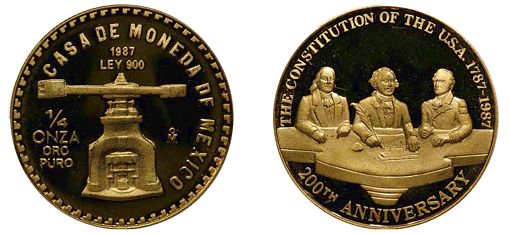 US Constitution 1/4 onza Gold
US Constitution 1/4 onza Gold
Two sizes are known.
| Ley(fineness) | weight | diameter | number minted |
|
| ¼ onza | 0.999 | 23.0 mm | ||
| 12 onzas | 0.999 | 80.0 mm |
Platinum
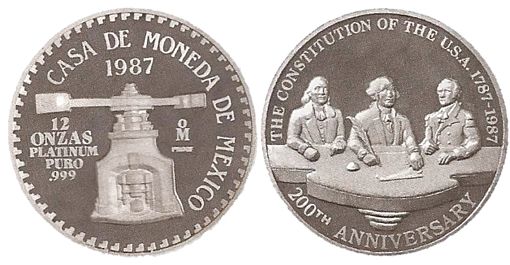 US Constitution 12 onzas Platinum
US Constitution 12 onzas Platinum
Is only known in one size, though it is suspected that a 5 onzas coin exists.
| Ley(fineness) | weight | diameter | number minted |
|
| 12 onzas | 80.0 mm | 500 |
These coins were distributed on the secondary market, mainly in the United States. So far it is known that there are two sets, one with the 12-onza silver coin and another with 1, 5, 12 onzas silver and ¼ onza gold coins.
5. Platinum Onza of 1987
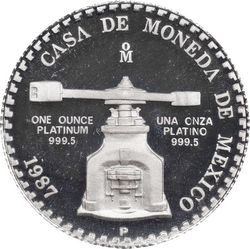
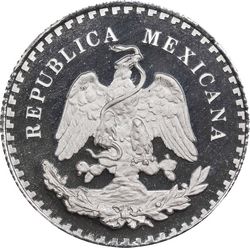
KMX-MB22. Platinum Onza, 1987-Mo P. (Stack’s Bowers Auction, 1 November 2023, lot 7228)
This piece of 1987 is bilingual. It is minted with a mirror finish, weighs 31.1 grams and has a diameter of 38 mm. According to sources only 270 pieces were minted, which seems was not the original target. I speculate that they intended to mint, say, 1,000 pieces but the die soon damaged and production was suspended, leaving the number minted at 270. This medal was distributed in a black case with English and Spanish commentary.
An interesting detail is that there is a letter “P” in the lower central part below the minting press. There are several theories explaining this - “P” as the initial or part of the name of the company or individual requesting the minting of this coin or “P” for platino or platinum (in English). Another interesting fact is that on the back does it does not give the correct name of the country “Estados Unidos Mexicanos” but “Republica Mexicana”.
6. Libertad Platinum ¼ onza, 1989
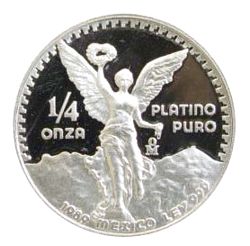
This is probably the best known platinum onza and is cataloged as “KM-539” . Furthermore, this is the only piece that the Banco de México and the Mint recognize in their listings. According to reports from the Banco de México 3,500 onzas were minted in a mirror finish with a diameter of 27 mm, but US sources claim that only 738 were minted because, as stated, platinum is a very hard metal and quickly damages the dies, leaving them unable to mint any more. Although this coin is dated 1989 it was produced in 1987 at the request of a foreign firm for preparing the Rainbow Set (Set Arcoíris) as explained below. This is another example of how many platinum pieces were destined for the foreign market.
7. The Rainbow Proof Set
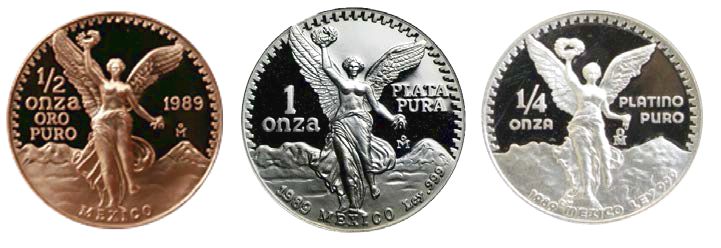 The sets of coins that the Banco de México along with the Mint issue year after year are a mystery. I understand that the first was in 1970 and came in a thin plastic envelope with a postage stamp of that year, although it is known that in the early 1960s some foreign companies had sets of coins, in BU and UNC state, known as “Mexican Dollars” or “Mexican Coinage”. Some time later it was realized that the plastic damaged the coins and the presentation was changed to rigid plastic cases with a blue interior.
The sets of coins that the Banco de México along with the Mint issue year after year are a mystery. I understand that the first was in 1970 and came in a thin plastic envelope with a postage stamp of that year, although it is known that in the early 1960s some foreign companies had sets of coins, in BU and UNC state, known as “Mexican Dollars” or “Mexican Coinage”. Some time later it was realized that the plastic damaged the coins and the presentation was changed to rigid plastic cases with a blue interior.
There were years when the Mexican authorities wanted to create sets for the foreign market commemorating a year or festival and showing the quality and beauty of Mexican coins. These sets are scarcer and more attractive than others; examples of this are the 1986 World Cup silver set, 1995 executive and luxury set, and the most recent in 2010.
In 1989 the Rainbow Proof Set (set Arcoíris) was issued. This set had been planned by a foreign company a few years earlier. It is very beautiful, expensive and rare and is so called because it contains three different metals with different hues (like a rainbow). This set is provided in a cherry-red box and contains a silver 1 onza, gold ½ onza and platinum ¼ onza, all dated 1989, in a mirror finish and encapsulated. Though produced in Mexico the coins were packed or assembled in the United States. According to records 3,500 sets were assembled, but in reality less than a thousand were produced and distributed.
The author wishes to thank the following people for their invaluable support which made this research possible: Angel Smith Herrera, Siddhartha Sanchez Murillo and José Angel Alvarez Diaz.
